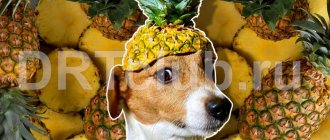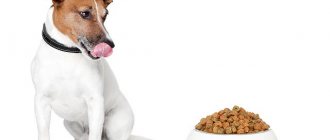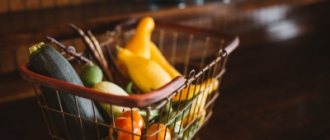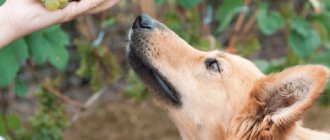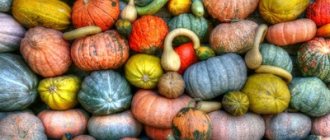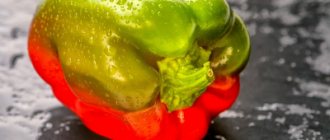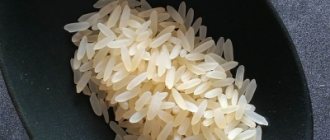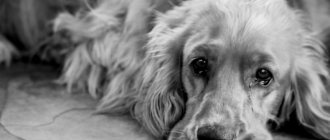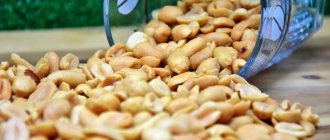Some dog owners do not know or do not want to understand that their pets are not omnivores, and feed them inappropriate and sometimes harmful foods. This approach to feeding a dog sooner or later leads to disastrous health consequences, and in advanced cases can be fatal. Below we will look at what you should not feed your dog, which foods are strictly prohibited for representatives of any breed, and can harm them.
What should you not feed your dog?
A little about dog nutrition
The digestive tract of dogs is structured somewhat differently than that of humans, therefore, the approach to preparing a diet for a barking pet should be different. Some owners, out of ignorance or irresponsibility, give their dogs almost every product included in the average person's grocery basket. Not only are dogs often fed from the common table, but they are also offered meals that the household members have not eaten. This approach is fundamentally wrong.
Digestive system of dogs
Firstly, dogs’ stomachs are “tuned” to eating raw food: meat, poultry, greens, eggs. When an owner offers a pet borscht or rice porridge with milk, it is contrary to nature itself, because a wild animal simply has nowhere to get such dishes; it is unnatural for it.
Secondly, the gastrointestinal tract of representatives of the canine world is configured for mono-nutrition, that is, monotonous day after day. The dog's stomach is unfamiliar with delicacies, the organ is not able to digest complex dishes or get used to the fact that each meal is significantly different from the previous one.
Feeding your dog from the table is the shortest route to a host of diseases.
This feature, again, is inherent in nature. The wild ancestors of domestic dogs had access to only those types of food that they could get by hunting. It would never even occur to a dog to mix meat with potatoes or cereal. The basis of the diet of these predators has always been raw meat and offal; occasionally the dogs ate fish, eggs, roots, herbs and grains.
Even carnivores eat greens to replenish the balance of essential nutrients
"BARF" system
It is for the above reasons that the BARF feeding system (translation from the English abbreviation BARF - biologically appropriate raw food), which imitates the diet of a wild dog, is gaining so much popularity in the world. Nutrition according to this system implies the postulates of feeding that we have already named. Every day the dog receives a lot of raw, unpeeled meat, including entrails and even safe bones (not tubular, which can break into fragments and injure internal organs).
Also in the bowl of a pet eating BARF there are always raw vegetables and fruits (not exotic), grated, vegetable oils, greens and herbs, nuts, roots, raw eggs (chicken, goose, quail). Sometimes owners give dogs cottage cheese, cereals, raw sea fish and seafood (for example, shrimp along with shells).
An example of a portion compiled according to the BARF system: veal, lung, tripe, carrots, sorrel
This system has its supporters and opponents, the main difficulty is that choosing a balanced BARF diet for a specific dog is not easy. Each animal is individual and requires a certain amount of fats, carbohydrates and proteins per day, as well as vitamins, microelements and other substances essential for life.
Competent owners select nutrition according to the natural system together with a veterinarian, having previously submitted the pet’s blood for a biochemical analysis in order to clearly see the state of its body.
Dry food
For busy owners who do not have the desire or ability to calculate how many grams of each product a dog should get for dinner, good dry food is preferable. Today, the pet industry offers a great variety of high-quality food (super-premium and holistic classes). The owner only needs to select ready-made food according to the pet’s age, size or breed, as well as physiological characteristics and activity (long or short hair, moves a lot or prefers to lie down, and similar factors).
Examples of holistic dog foods
Before purchasing this or that food, you need to look at its composition. A quality product is determined by:
- A small number of ingredients (there are foods that contain only meat, plus some related elements).
- The first place in the list of ingredients should be meat, fish or poultry, preferably at least 50% of its content.
- Absence of all kinds of smell and taste imitators, pigmenting dyes and enhancers.
- The number of calories is twice or even three times greater than in similar weight but cheap food.
Modern manufacturers offer a wide variety of foods, including gluten-free, grain-free, hypoallergenic, and designed for dogs with intolerance to any foods.
Hypoallergenic food for dogs and puppies of all breeds
This is brief information to help you figure out how to create a balanced and proper diet for your dog, which will help maintain your pet’s health and prolong its life. Accordingly, products that are not suitable for dogs can be identified based on those that are suitable. Conventionally, we can divide food that should not be fed to a dog into three groups: unnecessary, prohibited and dangerous.
General rules for healthy eating
Having any pet is a big responsibility. Every owner always strives to give their dog the best. Good nutrition will be the key to keeping her energetic and healthy.
The following recommendations should be followed:
- Organization of feeding. Food should be appropriate for the age and size of the dog. A small breed puppy or dog needs less food. Young dogs need a higher protein intake than older dogs.
- Prevention of disease development. A large dog needs a type of feeding that prevents rapid growth to prevent the development of dysplasia. Therefore, it is advisable that they take special dog food with certain characteristics and in appropriate proportions.
- Recording daily physical activity. A dog that walks several kilometers a day, runs, or is very active needs extra energy to stay strong and healthy.
- Obesity prevention. A dog that eats more food daily than it should for its weight, size and daily physical activity is almost certainly a candidate for overweight or obesity.
- The choice of dog food is medium to high quality. Good quality feeds are more expensive, but they guarantee good digestibility. With high-quality foods, the dog's body gets the maximum benefit from all nutritional contributions. High-quality food does not cause plaque to appear on the teeth, and the occurrence of gingivitis or inflammation of the gums is excluded.
- Removing junk food from reach. Overeating leads to problems with the gastrointestinal tract and is fraught with the development of obesity.
Do not use food rewards as a supplement to your daily ration. A product with a low calorie content is suitable for this, so that the pet does not suffer from overweight and obesity. Do not neglect this rule so as not to disrupt the health and quality of training.
Any dietary decision should be discussed with your veterinarian. Consultation is essential for the owner of a sick dog or a dog with special nutritional needs. The doctor will indicate the correct ingredients and portions of food for each pet, based on weight, breed and lifestyle.
Your dog should always have access to clean drinking water. Water is vital for the health of the animal, especially during the hot season. New dishes should be introduced into your pet’s diet gradually. When introducing new food without restrictions on the quantity, the dog may experience vomiting and diarrhea.
Foods you shouldn't give your dog
Every dog owner should know the main rule - if you are not sure that the product will benefit your pet, there is no need to offer it. Just like for people, for dogs there is a set of products that are food waste. In fact, they do not cause any particular harm to the animal’s body, but they also do not bring any benefit. Accordingly, the dog simply passes them through his stomach.
Table 1. Foods undesirable for dogs
| Product | Cause |
| Oatmeal, rolled oats | They are not absorbed in the body and do not bring useful substances. |
Watermelons, melons | If a melon or watermelon is grown independently, it does not bring any benefit or harm to the animal. Store-bought watermelons and melons can be treated with pesticides and cause fatal poisoning to your dog. |
| Cabbage | Poorly absorbed, can cause bloating and gas formation. |
Milk | Fresh cow's milk is a product that dogs do not need. In large quantities it can cause diarrhea, and in case of lactose intolerance - allergies. |
Potato | It is useless for the animal's body in cooked form, and can be toxic in raw form. |
Meat or fish broths | Intended only for feeding sick or postoperative animals. For an adult dog, broth will bring nothing but quenching thirst and a full bladder. |
| Pearl barley | It does nothing for the dog’s body, and in large quantities it can irritate the stomach walls. |
Cheap dry food | They serve as a means to fill the stomach, as they have a poor composition, low calorie content and an insignificant content of useful substances. |
| Salt | Some owners add salt to their pets' portions, but they don't need it at all. In small doses, salt is useless, in large doses it is harmful. |
Raw river fish | It is no different from a sea dog, but there is a high risk that the dog will become infected with parasites, including those dangerous to humans. |
Boiled meat, poultry, offal | The maximum permissible is to first freeze the meat, and after defrosting, pour boiling water over it. Boiled meat does not contain substances that are beneficial for dogs, and such food simply takes up space in the stomach. |
Prohibited foods in large quantities
There is a common belief that everything is medicine and poison, depending on how much you consume. So there is no need to reach the point of stupid fanaticism.
- If you want to pamper your pet with something tasty, then give him a treat, but in small quantities.
- But we must take into account that this does not apply to old, sick and allergic dogs.
- Small breeds of dogs have a very vulnerable pancreas, so they also need to be protected from “treats”.
Prohibited foods for dogs
This category includes foods that can harm a dog’s body. If an animal regularly consumes prohibited foods, all vital systems suffer, especially the stomach, liver and pancreas. A caring owner will never offer his dog products from the table below.
Table 2. Foods that should not be given to dogs
| Product | Cause |
Soups | Soup prepared for the human table is not dog food. Firstly, when feeding liquid, the animal’s teeth deteriorate and the jaw muscles atrophy. Secondly, the mixture of ingredients is not suitable for the gastrointestinal tract of a predator, and provokes all kinds of diseases. Seasonings added to soups cause heartburn and gastritis in dogs. |
| Fast food, fried foods | They put a huge strain on the liver and pancreas. They provoke excess weight, a sharp jump in blood sugar, contribute to dysfunction of the genitourinary system, the formation of sand and stones in the excretory organs. They cause an increase in cholesterol and salt deposits in the bones of the animal. |
Cheese | A fatty product that puts a high load on the liver. May cause allergic reactions. |
Flour products, bread | They clog the stomach, cause fermentation, flatulence, and have a bad effect on the animal’s teeth, causing caries. |
Legumes | They are poorly absorbed, cause gas formation, and swell in the stomach, causing discomfort and heaviness. |
| Avocado | This fruit contains persin, a substance toxic to dogs that causes vomiting, diarrhea, stomach disorders and diseases. |
Citrus | Large amounts of vitamin C cause vomiting, allergic attacks, and inflammation of the digestive tract in dogs. |
Mushrooms | They pose a danger to the liver and pancreas and may contain dangerous toxins. |
Butter, lard | Contain fats that contribute to the development of pancreatitis in dogs. |
Dry cat food | Contains taurine, which is harmful to dogs; in addition, cat food has a composition that is balanced specifically for these animals, so regular consumption of cat food by a dog causes dysfunction of all organs and has a bad effect on overall health. |
Any human food, especially fast food, is harmful to dogs
What can you sometimes give to dogs?
Some foods can only be given in limited quantities. Otherwise they will not be of any use.
Apricots, persimmons, kiwi
Eating large amounts of apricots may cause your dog to develop diarrhea. Persimmon in small quantities is beneficial - normalizing intestinal motility. Kiwi is given to replenish ascorbic acid deficiencies - but not more than 2 slices per month.
Berries
strawberries, raspberries, currants and cherries) are an allergenic product, so their quantity should be limited. Small portions are acceptable - 2-5 pcs. in a day.
Egg
Salmonella poisoning and biotin deficiency are two things to be careful about when feeding your dog a raw chicken egg. It is safest to give your dog a cooked product. A chicken egg is a source of protein. It contains many vitamins for your pet.
Cheese
Dogs can eat cheese in small to moderate amounts. As long as there is no lactose intolerance, which is rare but still possible in dogs, cheese can be a good snack. Many types of food can be high in fat, so choose low-fat varieties such as cottage cheese or mozzarella.
Honey
Sometimes dogs can eat honey. It contains countless nutrients such as vitamins A, B, C, D, E and K, potassium, calcium, magnesium, copper and antioxidants. Feeding dogs a small amount of honey can help with allergies because it introduces small amounts of pollen into their bodies, strengthening their immunity to allergens in your area.
Peanut butter
Peanut butter is a source of protein for dogs. It contains heart-healthy fats, vitamins B and E, and niacin. Unsalted peanut butter is the healthiest option. Read the label carefully to make sure the product does not contain xylitol, a sugar substitute that can be toxic to dogs.
Popcorn
Dogs can eat popcorn. Unsalted, oil-free, popped corn is fine for dogs in moderation. The product contains riboflavin and thiamine, which promote eye health and digestion, as well as small amounts of iron and protein. Be sure to shake out any hard kernels completely before giving popcorn to your dog, as they can be a choking hazard.
Pork
Pork is a highly digestible protein rich in amino acids. The product contains more calories than other meats. Pork may also be less likely to cause an allergic reaction in some pets compared to other proteins, so amounts should be limited.
Salmon
Properly cooked salmon contains a lot of protein, healthy fats and amino acids. The product promotes healthy joints and brain and strengthens the dog's immune system well. However, raw or undercooked salmon contains parasites that can make dogs sick, causing vomiting, diarrhea, dehydration and, in extreme cases, even death.
Shrimps
A few shrimp from time to time are acceptable for a dog, but only if they are properly cooked and the shell (including the tail, head and legs) is completely removed. Shrimp is rich in antioxidants, vitamin B-12 and phosphorus, but low in fat, calories and carbohydrates.
Tuna
In moderation, cooked fresh tuna contains omega-3 fatty acids, which promote heart and eye health. Canned tuna contains small amounts of mercury and sodium, which should be avoided.
Turkey
Turkey is suitable for dogs, but it must be cooked properly. Be sure to remove excess fat and skin from the meat. Be sure to check for any bones that may splinter when chewed, causing an intestinal blockage or even rupture. Meat should not be served with excessive amounts of salt, seasonings, onions or garlic.
Cereals
Dogs should have grain in their diet. Wheat contains vegetable protein, essential fatty acids and fiber. Avoid if you have an individual intolerance or predisposition to allergies.
Dangerous foods for dogs
Above we have listed those foods that are undesirable and harmful for any dog, but are not capable of causing immediate and serious harm to health. Unnecessary and forbidden food for a dog slowly destroys the animal’s immunity, negatively affects all vital systems, but is not fatal.
A responsible owner will never offer a dog dangerous food.
But, there are also products, even a single use of which can threaten the dog with terrible symptoms that require the intervention of a veterinarian, and in the worst case, death. Not only should you not give such food to a dog, but you should also be vigilant so that the animal cannot get it on its own (steal it, find it and pick it up on the street).
Table 3. Products hazardous to the health and life of dogs
| Product | Cause |
Alcohol-containing drinks, hops | Any alcoholic drinks, especially carbonated ones, sharply undermine the functioning of the cardiovascular and nervous systems. For dogs, this can lead to paralysis and death. |
| Chocolate | Chocolate contains theobromine, a stimulating substance that can cause arrhythmia, tachycardia in a dog, and instantly spread into the bloodstream. May cause cardiovascular disease and cardiac arrest. |
Tubular bones | They are dangerous either raw or cooked. When a dog chews such a bone, razor-sharp fragments enter the digestive tract. Fragments of tubular bones can open the walls of internal organs and cause instant death. If the fragments get safely into the stomach, they accumulate there, causing obstruction. Passing into the intestines, tubular bones provoke constipation or ruptures of the rectum. |
Apple seeds | They contain cyanide, which causes respiratory arrest and convulsions in dogs. |
Raisins, grapes | Toxic to dogs, causing acute renal failure and intoxication of the body. |
| Chewing gum | Xylitol, which is part of all chewing gum, sharply increases sugar levels and provokes liver dysfunction. |
| Nutmeg and macadamia | These nuts contain substances that are terrible for dogs, poisoning the digestive system and paralyzing the nerve endings. Several nuts eaten by an animal cause convulsions, rapid heartbeat, and coma. Eating nutmeg and macadamia can lead to death for your pet. |
Yeast dough | Causes severe fermentation, up to rupture of the abdominal walls and peritonitis. If a dog eats a large piece of raw yeast dough, it may experience gastric volvulus, which without surgical intervention leads to death. |
Plums, peaches | They cause obstruction of the digestive tract, contain cyanide, which causes convulsive seizures and coma in dogs, and a high risk of death. |
Tobacco leaves | Instantly causes dysfunction of the heart muscle and depresses the nervous system. The animal may fall into a coma and not come out of it. |
| Onion garlic | In large doses, they are extremely toxic to the animal, provoke anemia, oxidize and destroy hemoglobin and erythrocyte cells |
Persimmon | The astringent fruit provokes gastritis and ulcers in dogs, obstruction of the gastrointestinal tract, inflammation of the mucous membranes, and enteritis. |
Chocolate and other sweets should be stored in a place inaccessible to the dog.
It's just like people
Chocolate - theobromine contained in it causes bloating, vomiting, diarrhea, arrhythmia, convulsions, and in large quantities can be fatal.
Dogs love chocolate very much and, if the owner is irresponsible, can find and eat the treat on their own. And to remove this toxin from the body, you will need a lot of money and time spent on repeated trips to the veterinarian.
- Alcohol leads to nervous convulsions, heart failure and death.
- Baking with yeast leads to fermentation in the intestines, resulting in abundant gas formation, which, in addition to an unpleasant odor, causes pain in the animal.
If a dog eats raw dough, it can cause intestinal volvulus, which can be fatal.
Tea and coffee - the caffeine they contain leads to rapid heartbeat, aggressive behavior, and increased blood pressure.
What to do if your dog has eaten a dangerous product?
If a prohibited or dangerous product is swallowed by an adult healthy dog, the chances of saving its life and health, without negative consequences, are high. The main thing is that the owner discovers the problem as soon as possible, is able to provide first aid to his pet, and, if necessary, promptly delivers the dog to the veterinary clinic.
So, if a dog has swallowed raisins or grapes, the symptoms will be as follows (one berry is unlikely to cause these signs, a handful will easily):
- loss of appetite;
- apathy;
- repeated liquid diarrhea;
- convulsions;
- the smell of acetone from the dog’s mouth and skin;
The animal must be taken to the clinic, where gastric lavage, intravenous drips will be performed, and medications will be prescribed to restore diuresis.
Toxins are eliminated by drugs administered by drip
An animal that has swallowed chocolate or another product containing caffeine or cocoa beans will soon begin to breathe rapidly and shallowly, its pulse will increase, muscle tremors, vomiting, and fever will appear. Further, the symptoms will worsen: diarrhea, involuntary urination, and seizures will be added to the above symptoms.
If you suspect that your dog has eaten chocolate, you need to give it activated charcoal (one tablet per kilogram every three hours). It is advisable to give the animal plenty of water so that the toxin comes out along with the urine and is not absorbed into the blood. The best option would be to take the animal to a clinic, where the water balance will be restored with droppers, and the heart condition will also be monitored with an ECG machine.
A dropper with saline solution will help improve the urination process.
If a dog has eaten yeast dough or somehow ingested alcohol (both products contain ethanol), the owner has very little time to get the animal to the doctor. Signs of poisoning appear quickly: the pet loses coordination, is barely able to move, excitement is replaced by a depressed state, and in the case of eating the dough, a swollen belly is added to the symptoms.
It is impossible to treat a dog at home; in the hospital, the animal’s stomach will be washed out (in the case of alcohol); if there is dough in the stomach, rinsing cannot be done; surgery is indicated.
A dog's swollen belly is a reason for emergency hospitalization
If you suspect that your dog has eaten chewing gum or other products and products containing xylitol (toothpaste, candy for diabetics), you should urgently take the animal to the clinic. The fact is that within half an hour irreversible changes will begin in the body, in particular, damage to the kidneys and liver.
In this case, the animal reacts with acute vomiting, convulsions against the background of complete depression, the dog’s vision decreases, followed by bloody stools, then coma. Treatment can be prescribed in the hospital, while monitoring the levels of liver enzymes and glucose in the bloodstream.
Video - Foods harmful to dogs
What happens in a pet’s body when feeding “from the table”
Of course, if you feed your dog and cat borscht with sour cream, they will not die, but regularly feeding such food can undermine their health. An organism that does not receive the substances it needs and is forced to constantly “dispose” of excess carbohydrates, fats, and fiber will begin to use up its own reserves and use all possibilities for the synthesis of the elements and compounds it needs.
In the course of evolution, all living beings have developed a sufficiently large “margin of safety” that allows them to survive difficult times. But if these times still don’t end, then, you know, miracles don’t happen. Reserves run out and illnesses begin.
Metabolism is disrupted
First of all, this is a whole complex of metabolic disorders that develop in dogs and cats as a result of improper nutrition. With prolonged feeding of dishes from the table, a chronic lack of protein, essential amino acids - methionine, tryptophan, arginine, microelements (iron, cobalt, manganese, zinc, selenium, iodine), macroelements - calcium and phosphorus, vitamins (A, C, D, E) are observed , K and group B).
All this is superimposed on excess fats and carbohydrates, resulting in a serious imbalance, leading to disruptions in physiological processes - the synthesis of hormones and vitamins, biochemical reactions, cell renewal of organs and tissues.
During the examination, pathological changes in the bone structure, thyroid dysfunction, elevated levels of glucose and lipids in the blood, and fatty liver are detected in dogs and cats. At the same time, animals very often suffer from overweight and obesity, and diabetes often develops. The coat becomes dull and falls out, the condition of the skin worsens, and dandruff appears.
Is there a need for a more eloquent answer to the question: “Is it possible to feed human food to domestic animals?” I think not. It is obvious to anyone who cares about the health of a pet, for which only the owner is responsible.
Other foods and substances that dogs should not eat
There are a great many products whose benefits for dogs are questionable, but the harm, although moderate, is very real. These include the meat of wild animals hunted by humans. The fact is that raw meat purchased at the market must have the necessary veterinary certificates, but it is impossible to control the quality of game. Since heat-treated meat is useless for dogs, and raw elk, wild boar or bear meat can contain a lot of parasites, it is better not to offer such “delicacies” to the animal.
Don't feed your dog hunting trophies.
The dog does not need to be fed not only the meat of animals obtained by humans, but also the accidental or intentional “fruits” of the hunt of the animal itself. Many dogs, especially hunting breeds, do not mind finding a target to chase while walking. The dog can easily cope with small rodents, which can be carriers of terrible infections or have contact with poisons. To avoid unwanted hunting, pets that have the appropriate instincts are let off the leash by putting a muzzle on them.
Rodents are very dangerous for pets
Although most raw vegetables are good for dogs, celery should be left off the list. Its stems are too hard and thick, and given that dogs do not know how to chew and swallow food in pieces, they can clog the esophagus. Corn is also not recommended for consumption. In the cob, it can also cause blockage of the gastrointestinal tract; in addition, the grains cause a sharp jump in blood sugar and can provoke allergies.
Is table food good for cats and dogs?
First of all, you need to understand what human food is. Even if we exclude from it semi-finished products, sausages and frankfurters, which are not complete nutrition not only for animals, but also for people, what remains is a combination of various types of fried, boiled or stewed meat, sources of carbohydrates - cereals and flour products, vegetables, fruits , as well as various fats, both animal and vegetable.
Such a variety and mixture of ingredients is a complete nutrition for a person, since by nature he is omnivorous, which means his body is able to extract the substances it needs from almost any organic matter. Dogs and cats, which are carnivores, are not designed this way at all.
Features of digestion in dogs and cats
Their digestive system is designed to consume animal proteins. They have a short gastrointestinal tract, their saliva does not contain the amylase enzyme, which promotes the primary digestion of plant foods, and their body cannot independently synthesize vitamin D, the source of which is only animal products.
And if dogs can still independently produce such essential amino acids as niacin, taurine and arginine, then cats are deprived of this too - their body receives energy only in the process of gluconeogenesis, that is, the metabolism of glucose from non-carbohydrate compounds.
In addition, human dishes are usually generously seasoned with salt, spices, sauces, and various additives designed to satisfy the highly developed taste buds of humans, but are completely useless and even harmful to animals.
What to do if your dog begs for junk food?
Many dogs, especially those living with inexperienced or kind-hearted owners who feel sorry for the “hungry baby,” tend to beg. But every owner should know that by holding out his palm to his pet with a piece of a prohibited product, he is doing a disservice to both the dog and himself. Even a small piece of dangerous food for a pet can cause irreversible consequences in its body.
The best option would be to limit the dog's access to the kitchen or other room where people eat. You just need to leave your pet behind a closed door or block its passage. The main thing is to remain firm in your intention. You can send the dog to the place, offer him a toy or a special dog treat, for example, a deer antler.
Deer antler will keep your pet occupied for a long time and will not harm its digestion.
All household members, as well as guests, should know that it is forbidden to feed the dog from the table or treat it with any products that are not included in the main diet of the animal. If there are small children in the house, you need to closely monitor that the baby does not treat his furry friend with chewing gum or chocolate candy.
The animal will quickly understand that the owner does not intend to share food with him. There is no need to feed your dog while preparing food, even offering it approved foods, such as a piece of raw chicken or cucumber. The exception is the training process, where the dog receives tidbits for correctly executed commands.
Important point! Treats for training must be chosen wisely. You should not give your dog cheese or sausage. The best option would be dry food pellets, dried beef or lamb lung.
The dog should not be allowed to put its muzzle on the table, much less its paws.
The pet must eat according to a certain schedule; usually adult dogs are fed twice a day - after a morning and evening walk. There should be a special place for eating, outside of which the dog should not receive food. During the day, the bowls should be empty, the only thing is that the animal should always have access to an unlimited amount of clean, cool water.
If a dog steals food
Dog handlers offer an interesting way to quickly wean an animal from stealing food from the table. The owner must prepare a fairly large piece of meat, chicken or other product that the dog loves and is not prohibited for it. The tidbit is placed on the very edge of the table so that it hangs down and attracts the dog's attention. The animal must be removed from the room during preparations.
A well-mannered dog ignores food until the owner allows him to take it.
On top of a piece of meat you need to build a “tower” of any objects that do not break when falling, but make loud sounds. These can be small iron mugs, plates, plastic glasses into which cutlery is placed. Then the man leaves the room, letting the dog in. It’s easy to guess that as soon as the pet takes the forbidden food, a pyramid of dishes will collapse on him with a roar. This technique is designed to scare the animal and permanently discourage it from stealing.
How to stop a dog from picking up on the street?
A dog can not only receive dangerous products from a person or steal them, but also pick them up on the street while walking. Stopping this unwanted behavior means protecting the animal from poisoning and death. What should the owner do? First of all, teach the puppy to wear a muzzle. If this is not possible due to the small size of the dog, the owner must be much more careful.
To prevent the dog from “vacuuming” the area, you need to work hard. Few animals are indifferent to the tasty morsel lying under their feet. The best option would be to attend group training classes, where, first of all, the ban on picking up from the ground is practiced. To do this, odorous foods (pieces of cookies, meat, sausages) are specially scattered around the dogs.
It’s not easy to stop a dog from picking up food from the ground, but it’s possible.
Next, the owner takes the animal on a leash and leads it past the place where the food is scattered. As soon as the dog reaches out to grab a piece, the owner must clearly give a prohibiting command - “Ugh” or “No”, and pull the leash towards himself. If the dog obeys, it receives a treat, but it is already permitted and from the hands of the owner. A person must be vigilant - dogs have an excellent reaction, and the pet can grab the “forbidden” before the owner gives the prohibiting command.
Several such trainings, and the pet will go - it is much more profitable to follow the owner’s command and receive a tasty reward than to pick up a piece from the ground and be punished. For this reason, you should not let a dog off leash if it has not been trained to ignore food lying underfoot. If the dog nevertheless picks up something while in free flight, the owner’s task is to call the animal and exchange the picked piece for a treat.
Owners of young dogs should always carry a treat with them for encouragement.
Important point! If you shout at an animal or try to hit it when it picks it up from the ground (especially while without a leash), you can achieve the opposite effect. The dog will quickly understand that the owner will take the tasty morsel (even if it is a rotten piece of meat or garbage), and in addition will punish it. You need to teach the dog to change and let him understand that he will receive food as a reward in any case, so you should not swallow the found food immediately.
Adviсe
Some recommendations for feeding from veterinarians:
- The diet should contain fresh meat (preferably beef). Trim off excess fat to avoid digestive problems. Avoid including cattle hooves, bones, kidneys, tails and lungs.
- When buying meat, you need to make sure that the products have been properly tested before going on sale and do not contain dangerous microorganisms and helminths.
- The daily portion of meat depends on age. If the dog is young and lives outside in winter, more of this product is needed. For pets who live in the house, give a little less meat.
- It is better to cut the products into small pieces, 1-3 cm each. Do not turn the products into porridge by chopping them too much. The chewing process is beneficial.
- Eating outdoors accumulates bacteria and moisture. Close the food bag tightly and store it in a suitable place. Keep non-dry food in the refrigerator after opening the package.
- It is necessary to pay attention to the shelf life of wet products; they have a shorter duration.
- You should not give your dog table scraps; they provide him with more fat than nutrients.
- Wash feeders and drinkers thoroughly, as over time they become dirty, causing water and food to become rancid.
Dogs are not picky eaters. But this does not mean that everything they eat is good for them. Responsibility for the diet rests entirely with the owner. Create a menu for your dog, first study healthy and unhealthy foods. Consider your pet's preferences, but remember that some foods can be harmful. Be sure to consult your veterinarian in advance.
Summarizing
Many people are confident that dogs can decide for themselves how to eat and will never beg for or eat harmful and dangerous foods. It is not true. Animals cannot assess the degree to which a particular substance is needed in their body. If a dish or product has an attractive smell, the pet will try to get food in any way.
From the first days when the puppy appeared in the house, owners must strictly prohibit him from stealing from the table
Also, the owner of the dog and his family members must agree that no one will feed the animal from the table or from hand, out of pity for the “sad hungry eyes,” offering the pet forbidden food. Without handouts, the dog will feel healthy and live a long life, and even a small piece of chocolate can bring great grief to a family that has unexpectedly lost a beloved dog.
What should not be given to dogs as food on a regular basis?
Photo source pixabay.com
- Milk
After 5 months, the puppy’s body stops producing lactose, which leads to the negative effects of milk - allergies, rashes, vomiting. In practice, many animals retain lactase and may see milk-type protein. Goat milk, which contains casein, is best. But if it is not available, ordinary farm water mixed with boiled water (1 to 1) will do. It is forbidden to take dry formula or powdered milk for children as a substitute.
- Cheese
Forbidden fruit for small breeds or individuals with a weak pancreas. It causes diarrhea. For healthy animals, low-fat homemade cottage cheese (without salt) is suitable. It will be a good treat during training.
- Strawberry, blueberry, apple
This is a healthy part of the diet. Fruits and berries contain a lot of fiber, which aids digestion. It is important not to feed the animal with them, but to remember about other nutritional elements.
- Cabbage
It is a harmless product if consumed in moderation. If you overdo it, the body’s reaction is flatulence. The main thing is not to feed your pet anything you are not sure about. If your health declines, you should immediately contact a veterinarian.
